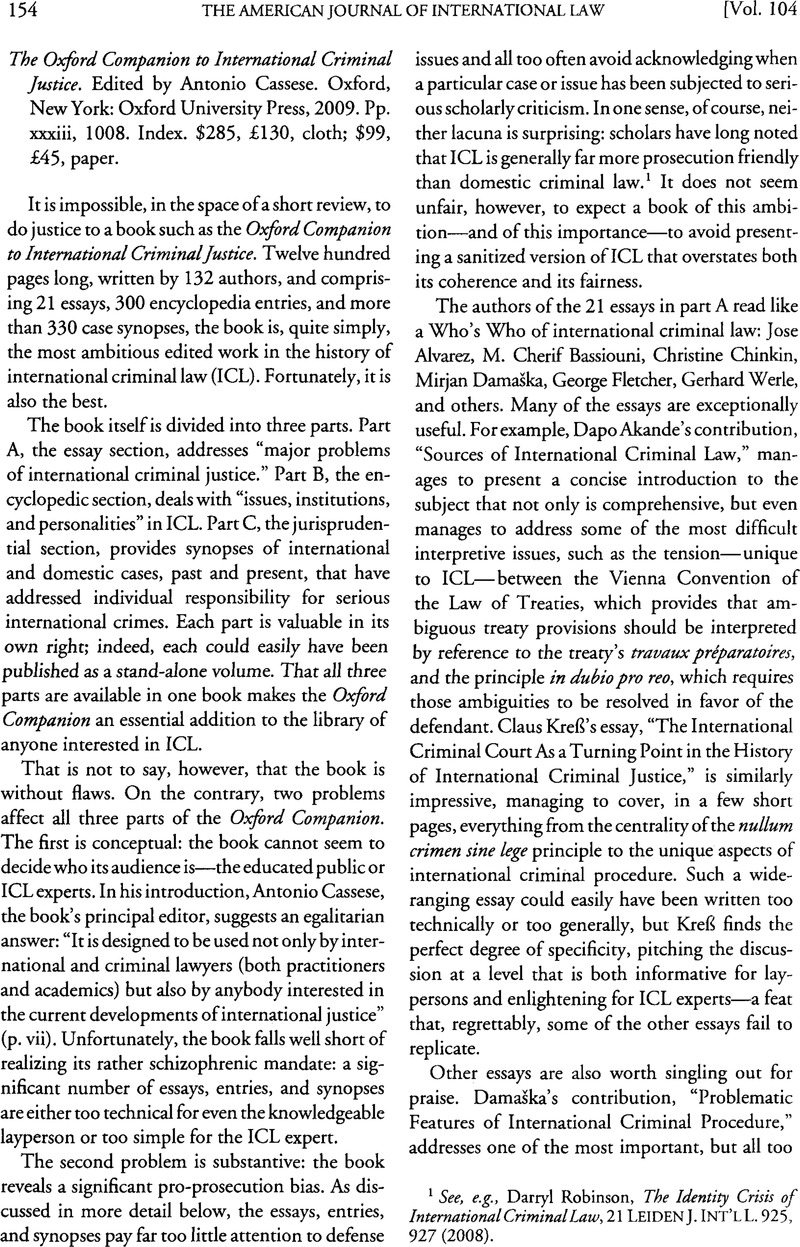No CrossRef data available.
Published online by Cambridge University Press: 27 February 2017

1 See, e.g., Darryl, Robinson, The Identity Crisis of International Criminal Law, 21 Leiden J. Int’l L. 925, 927 (2008)Google Scholar.
2 See, e.g., David, Cohen, “Hybrid” Justice in East Timor, Sierra Leone, and Cambodia: “Lessons Learned” and Prospects for the Future, 43 Stan. J. Int’l L. 1, 6–23 (2007)Google Scholar.
3 See, e.g., Alexander, Zahar & Göran, Sluiter, International Criminal Law 226–27 (2008)Google Scholar.
4 See, e.g., Steven, Powles, Joint Criminal Enterprise: Criminal Liability by Prosecutorial Ingenuity and Judicial Creativity? 2 J. Int’l Crim. Just. 606, 615 (2004)Google Scholar. JCE III refers to the “extended” form of joint criminal enterprise, which holds a defendant criminally responsible for unplanned crimes committed by a member of the JCE that the defendant foresaw might be committed.
5 See, e.g., Gerhard, Werle, Principles of International Criminal Law 115 (2005) (describing the mens rea of JCE III as recklessness)Google Scholar.
6 See, e.g., Sienho, Yee, The Tu Quoque Argument As a Defence to International Crimes, Prosecution, or Punishment, 3 Chinese J. Int’l L. 87, 106 (2004)Google Scholar.
7 See, e.g., George, Fletcher, Rethinking Criminal Law 442 (2000)Google Scholar.
8 Id. at 445.
9 Id. at 443.
10 See, e.g., Andrew, Ashworth, Principles of Criminal Law 183 (2d ed. 1995)Google Scholar.
11 See, e.g., Fletcher, supra note 7, at 447.
12 See, e.g., Joshua, Dressler, Understanding Criminal Law 167 (4th ed. 2006)Google Scholar.
13 See, e.g., Telford, Taylor, Nuremberg Trials: War Crimes and International Law, 450 Int’l Conciliation 243, 342–44 (1949)Google Scholar.
14 See, e.g., Robert, Cryer Et Al., An Introduction to International Criminal Law and Procedure 329 (2007)Google Scholar.
15 See id. at 328.
16 See, e.g., John, P. Cerone, Status of Detainees in Non–international Armed Conflict, and Their Protection in the Course of Criminal Proceedings: The Case of Hamdan, v. Rumsfeld, Asil Insights, July 14, 2006 Google Scholar, at http://www.asil.org/insights0607l4.cfm.
17 See, e.g., Antonio, Cassese, International Criminal Law 258 (2d ed. 2008)Google Scholar.
18 The case is not alphabetized correctly, for some reason. It should come before “Nuremberg Trials” (p. 856).
19 Perhaps not surprisingly, the two entries were written by the same author.
20 See Cryer et al., supra note 14, at 177.
21 See, e.g., Zahar & Sluiter, supra note 3, at 129–30.
22 See, e.g., William, A. Schabas, Case Report: Barayagwiza v. Prosecutor (Decision, and Decision (Prosecutor’s Request for Review or Reconsideration)), 94 AJIL 563, 567–68 (2000)Google Scholar.
23 See Telford, Taylor, Final Report To The Secretary of The Army on The Nuernberg War Crimes Trials Under Control Council Law No. 10, at 108 (1949)Google Scholar.